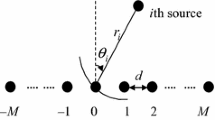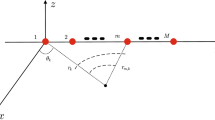Abstract
A new method for multiple sources localization is proposed to eliminate association ambiguity for near and far mixed field sources. A spatial source localization model in the modified polar representation was constructed without the prior knowledge needed if the source is near-field or far-field. The localization model for multiple sources was deduced by using all the possible permutation of the TDOA sequences obtained from the original array by GCC-PHAT and the generalized trust region optimization processing method. In order to eliminate the phantom sources in the multiple sources localization, a set of calibration sub-arrays was constructed by switching the reference microphone in the array. The TDOA sequences of the estimated possible sources and all actual sources to the calibration sub-arrays were calculated separately. A reliability evaluation function was constructed based on the two sets of TDOA sequences, as well as a reliability evaluation between the sources identified by all the calibration sub-arrays. According to the principle of minimization of the reliability evaluation function, the real sources were screened out to solve the association ambiguity. Comparison analyses through simulation and experiment on real speech datasets were carried out under different localization scenarios. The results of simulation are consistent with the experimental results, which show that the proposed method effectively eliminates the phantom sources, and has higher positioning accuracy and robustness than the comparison methods, no matter sources are in the near-field or far-field.


















Similar content being viewed by others
Data Availability
The datasets generated during and/or analyzed during the current study are available from the first author on reasonable request.
References
Y.T. Chan, K.C. Ho, A simple and efficient estimator for hyperbolic location. IEEE Trans. Signal Process. 42(8), 1905–1915 (1994)
C. Drioli, G. Giordano, D. Salvati et al., Acoustic target tracking through a cluster of mobile agents. IEEE Trans. Cybern. 99, 1–14 (2019)
J. Dan, Visualization techniques on exterior acoustic field of vehicle tailpipe. Ph.D., Tsinghua University, Beijing (2017)
X. Guo, Z. Chen, X. Hu, X. Li, Multi-source localization using time of arrival self-clustering method in wireless sensor networks. IEEE Access 7, 82110–82121 (2019)
K.C. Ho, Bias reduction for an explicit solution of source localization using TDOA. IEEE Trans. Signal Process. 60(5), 2101–2114 (2012)
K.C. Ho, S. Member, X. Lu, S. Member, L. Kovavisaruch, Source localization using TDOA and FDOA measurements in the presence of receiver location errors: analysis and solution. IEEE Trans. Signal Process. 55(2), 684–696 (2007)
C.H. Knapp, G.C. Carter, The generalized correlation method for estimation of time delay. IEEE Trans. Acoust. Speech Signal Process. 24(4), 320–327 (1976)
N. Kubota, Y. Toda, Multimodal communication for human–friendly robot partners in informationally structured space. IEEE Trans. Syst. Man Cybern. Part C Appl. Rev. 42(6), 1142–1151 (2012)
J. Liang, D. Liu, Passive localization of mixed near-field and far-field sources using two-stage MUSIC algorithm. IEEE Trans. Signal Process. 58(1), 108–120 (2010)
H. Liu, T. Kirubarajan, Q. Xiao, Arbitrary microphone array optimization method based on TDOA for specific localization scenarios. Sensors 19(19), 122 (2019)
Y. Li, R. Li, Y. Ye, X. Zheng, Z. Liu, J. Zhong, Z. Luo, Micro-jet particle field measurement using in-line Fraunhofer holography. Laser Technol. 28(001), 45–47 (2004)
Y. Mou, K. Xu, K. Xia, Unpacking the black box: examining the (de)Gender categorization effect in human-machine communication. Comput. Hum. Behav. 90, 380–387 (2019)
W.K. Ma, B.N. Vo, S.S. Singh, A. Baddeley, Tracking an unknown time-varying number of speakers using TDOA measurements: a random finite set approach. IEEE Trans. Signal Process. 54(9), 3291–3303 (2006)
R. Mukai, H. Sawada, S. Araki, S. Makino, Frequency-domain blind source separation of many speech signals using near-field and far-field models. EURASIP J. Appl. Signal Process. 2006, 113 (2006)
J.J. Mor, Generalizations of the trust region problem. Optim. Methods Softw. 2(3–4), 189–209 (1993)
H. Sundar, T.V. Sreenivas, C.S. Seelamantula, TDOA-based multiple acoustic source localization without association ambiguity. IEEE/ACM Trans. Audio Speech Lang. Process. 26(11), 1976–1990 (2018)
X. Su, Z. Liu, X. Chen, X. Li, Mixed incoherent far-field and near-field source localization under uniform circular array. Sensors 18(5), 1432 (2018)
Y. Sun, K.C. Ho, Q. Wan, Solution and analysis of TDOA localization of a near or distant source in closed form. IEEE Trans. Signal Process. 67(2), 320–335 (2019)
J. Scheuing, B. Yang, Disambiguation of TDOA estimation for multiple sources in reverberant environments. IEEE Trans. Audio Speech Lang. Process. 16(8), 1479–1489 (2008)
H. Shen, S. Member, Z. Ding, S. Dasgupta, Multiple source localization in wireless sensor networks based on time of arrival measurement. IEEE Trans. Signal Process. 62(8), 1938–1949 (2014)
S.A. Stotts, J.L. Martin, N.R. Bedford, Multiple-source localization using GPS technology and received arrival time structure analysis in an air-deployed system. IEEE J. Ocean. Eng. 22(3), 576–582 (1997)
Y. Sun, Single/multiple station localization method research in unified near-far-field model and III-conditioned matrix situation. Ph.D., University of Electronic Science and Technology of China, Chengdu (2019)
Y. Tian, Y. Wang, X. Rong, Q. Lian, Mixed source localization and gain-phase perturbation calibration in partly calibrated symmetric uniform linear arrays. Signal Process. 166, 107267 (2020)
B.F. Wu, C.L. Jen, Particle-filter-based radio localization for mobile robots in the environments with low-density WLAN APs. IEEE Trans. Ind. Electron. 61(12), 6860–6870 (2014)
K. Wang, Y.H. Liu, L. Li, A simple and parallel algorithm for real-time robot localization by fusing monocular vision and odometry/AHRS sensors. IEEE/ASME Trans. Mechatron. 19(4), 1447–1457 (2014)
B. Wang, J. Liu, X. Sun, Mixed sources localization based on sparse signal reconstruction. IEEE Signal Process. Lett. 19(8), 487–490 (2012)
Y. Wang, K.C. Ho, TDOA positioning irrespective of source range. IEEE Trans. Signal Process. 65(6), 1447–1460 (2017)
F. Yin, C. Li, H. Wang, F. Yang, Automatic acoustic target detecting and tracking on the azimuth recording diagram with image processing methods. Sensors 19(24), 124 (2019)
L. Yang, K.C. Ho, An approximately efficient TDOA localization algorithm in closed-form for locating multiple disjoint sources with erroneous sensor positions. IEEE Trans. Signal Process. 57(12), 4598–4615 (2009)
Acknowledgements
This work is jointly funded by the National Natural Science Foundation of China (NSFC) (Grant No. 51765017), the Natural Science Foundation of Jiangxi Province, China (Grant No. 20202BABL204043), and the Research Foundation of Transportation Department of Jiangxi Province, China (Grant No. 2015D0062).
Author information
Authors and Affiliations
Corresponding author
Additional information
Publisher's Note
Springer Nature remains neutral with regard to jurisdictional claims in published maps and institutional affiliations.
Rights and permissions
About this article
Cite this article
Liu, H., Chen, Y., Lin, Y. et al. A Multiple Sources Localization Method Based on TDOA Without Association Ambiguity for Near and Far Mixed Field Sources. Circuits Syst Signal Process 40, 4018–4046 (2021). https://doi.org/10.1007/s00034-021-01661-5
Received:
Revised:
Accepted:
Published:
Issue Date:
DOI: https://doi.org/10.1007/s00034-021-01661-5




